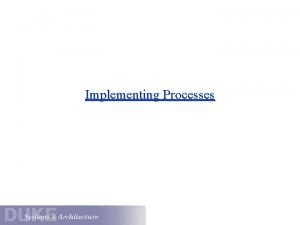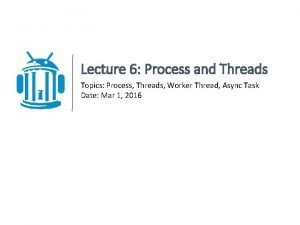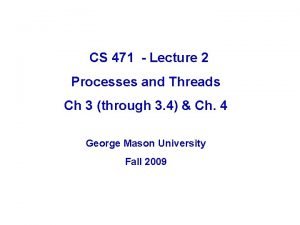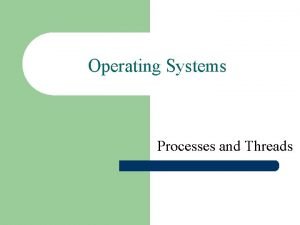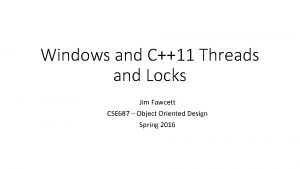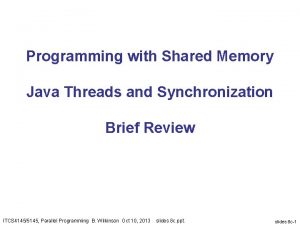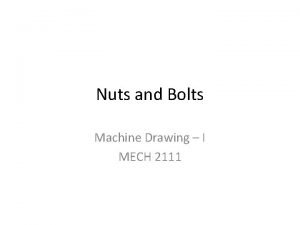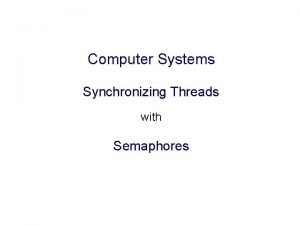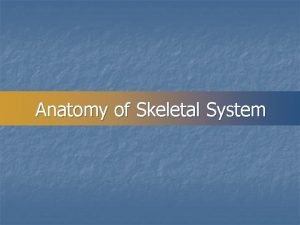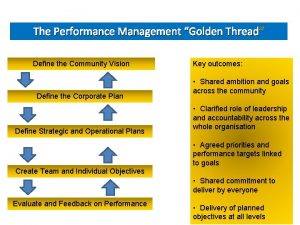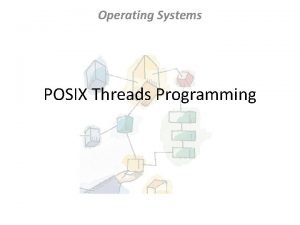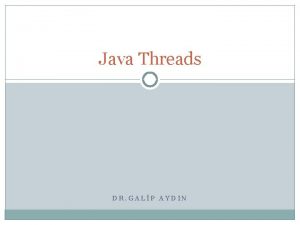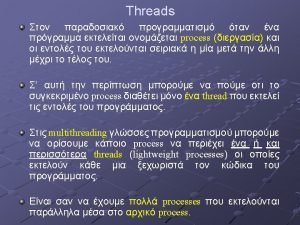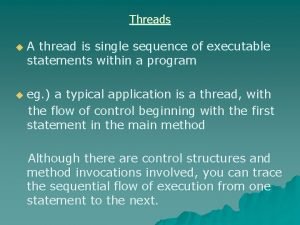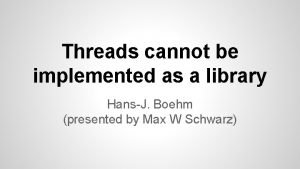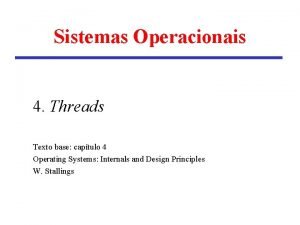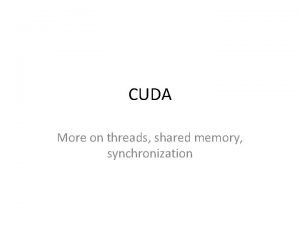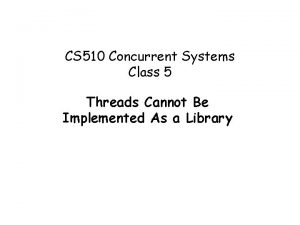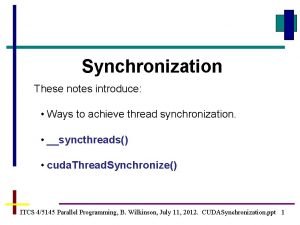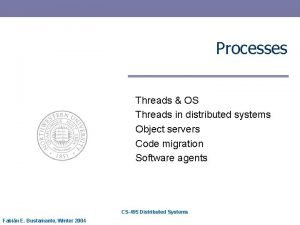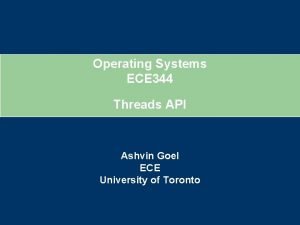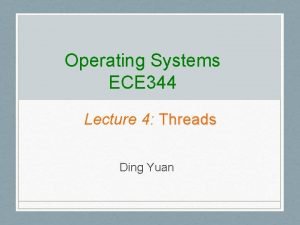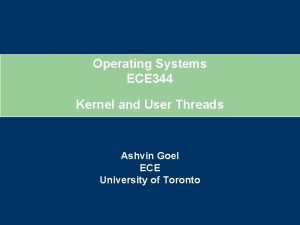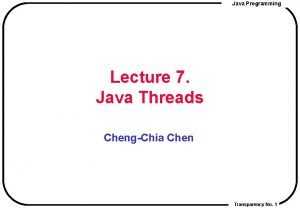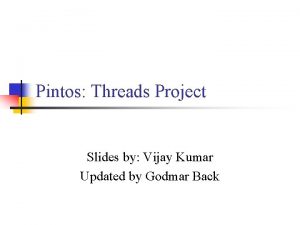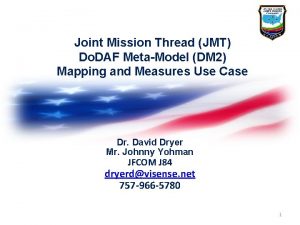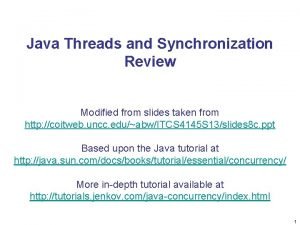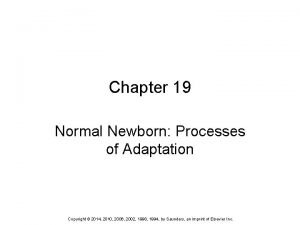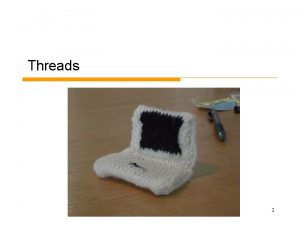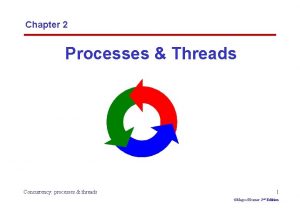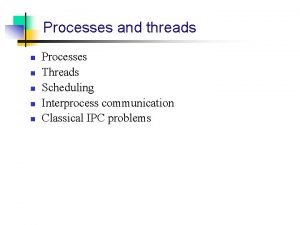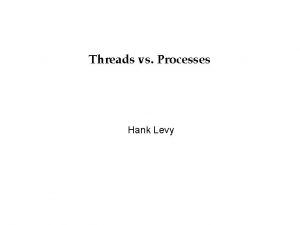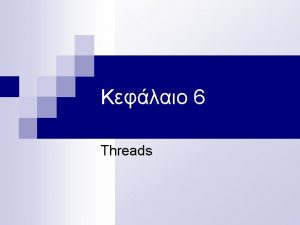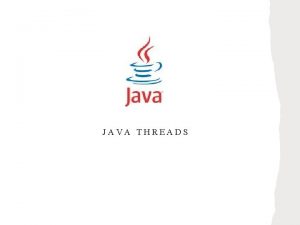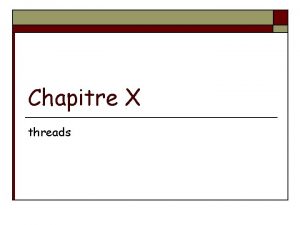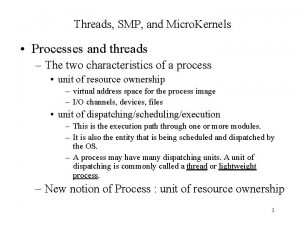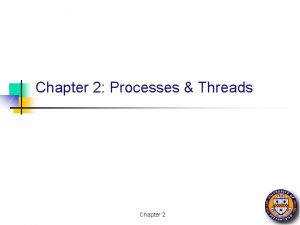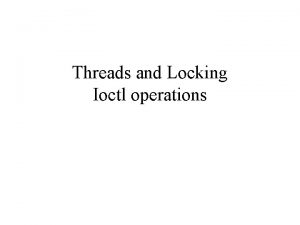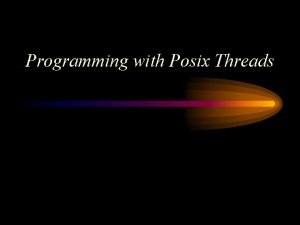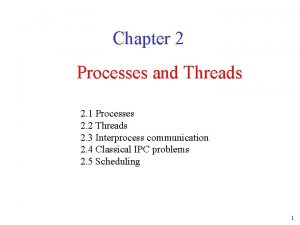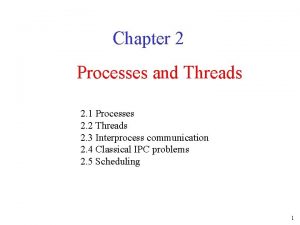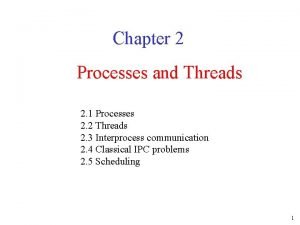Chapter 3 PROCESSES THREADS Processes and Threads in














































- Slides: 46

Chapter 3: PROCESSES THREADS Processes and Threads in Distributed Systems Thanks to the authors of the textbook [TS] for providing the base slides. I made several changes/additions. These slides may incorporate materials kindly provided by Prof. Dakai Zhu. So I would like to thank him, too. Turgay Korkmaz korkmaz@cs. utsa. edu Distributed Systems 1. 1 TS

Chapter 3: PROCESSES THREADS n THREADS Introduction to Threads l Threads in Distributed Systems l n VIRTUALIZATION The Role of Virtualization in Distributed Systems l Architectures of Virtual Machines l n CLIENTS and SERVERS Client-Side Software for Distribution Transparency l Server Clusters and their Management l n CODE MIGRATION Approaches to Code Migration l Migration and Local Resources l Migration in Heterogeneous Systems l Distributed Systems 1. 2 TS

Objectives n To understand threads and related issues in DS n To understand the role of virtualization in DS n To learn general design issues for clients and servers in DS n To understand code migration and its implications Distributed Systems 1. 3 TS

Introduction n We already studied processes in OS part, where the key issues were: 4 process management, scheduling, synchronization… n We also studied threads (sgg-ch 4) 4 User-level, kernel-level implementations, thread pool. . n Let us look at other equally important issues in the context of DS l Threads in DS l Client-server design l Code Migration Distributed Systems 1. 4 TS

Thread Review n Contrast Processes and Threads l Different address space vs. …. l CPU transparently switches processes vs. …. l Concurrency is costly (context switch) vs. … n Explain the advantages of threads l In case of a blocking call, multithreaded application can execute another thread l Exploit parallelism when executed on multiprocessor l Processes can only cooperate using IPC, requiring expensive context switch, while threads… l Make software development easier (e. g. , editor example) Distributed Systems 1. 5 TS

Thread Review Contrast user-level and kernel-level threads n +cheap, easy to n + Circumvent problems create/destroy threads in user-level threads (memory allocation/release) n - requires system call n +context switch is for every thread op done in a few instruction (no need to n -switching thread context is as expensive as switching processes change MMU, TLB, etc) n - blocking call will n Use hybrid form block the entire process (so no benefit in Lightweight process (LWP) editor : ) Distributed Systems 1. 6 TS

Thread Review . Light-Weight Process (LWP) n Lightweight process (LWP): intermediate structure Virtual processor: can execute user-level threads l Each LWP attaches to a kernel thread l n Multiple user-level threads a single LWP l Normally from the same process n A process may be assigned multiple LWPs n OS schedules kernel threads (hence, LWPs) on the CPU Distributed Systems 1. 7 TS

LWP: Advantages and Disadvantages n + User level threads are n Occasionally, we still easy to create/destroy/sync need to create/destroy LWP (as expensive as kernel threads) n + A blocking call will not suspend the process if we have enough LWP n Makes up calls (scheduler activation) n + Application does not l need to know about LWP + simplifies LWP management l - Violates the layered structure n +LWP can be executed on different CPUs, hiding multiprocessing Distributed Systems 1. 8 TS

THREADS IN DISTRIBUTED SYSTEMS Distributed Systems 1. 9 TS

Threads in Distributed Systems Example: Web client and server n Client (browser) starts communication in a thread. While it is waiting or getting the content, the other threads can do something else (e. g. , display incoming data, allow users to click links, get different objects etc. ) l Allow blocking systems calls without blocking the entire process n Server creates a new thread to service a request. Simplifies code (retains the idea of sequential process using blocking call) l Makes it easy to exploit parallelism l while() { { { keyboard input vs. socket 1 input } Distributed Systems keyboard input socket 1 input … … } } 1. 10 TS

Threads in Distributed Systems Another example: File server How can we implement this server? Distributed Systems 1. 11 TS

Threaded Implementations n Use multiple threads to improve performance Thread 2 makes requests to server Thread 1 reads requests Input-output Receipt & queuing T 1 Requests N threads Client Server How should the server handle the incoming requests? Distributed Systems 1. 12 TS

Threaded Servers Distributed Systems 1. 13 TS

. Performance of Threaded Programs n Assumptions l A single CPU & single disk system l CPU and disk can work concurrently n Suppose that the processing of each request l Takes X seconds for computation; and l Takes Y seconds for reading data from I/O disk n For single-thread program/process l What is the maximum throughput (i. e. , the number of requests can be processed per second)? Distributed Systems 1. 14 TS

. Performance of Threaded Programs (cont’d) n Suppose multi-thread implementation l Single CPU & single disk system l How many threads should be used? 4 Excessive 4 Optimal l number of threads higher overhead number of threads to be used What is the maximum throughput (i. e. , the number of requests can be processed per second)? n Where is the bottleneck? l The slowest component determines the performance n How to improve without extra hardware? l If I/O is slow use main memory as data cache Distributed Systems 1. 15 TS

. Performance of Threaded Programs (cont) n What about m-CPU and n-disk system l How many threads should be used? l What is the maximum throughput (i. e. , the number of requests can be processed per second)? n How to achieve a given throughput? l Balanced number of CPUs and I/O disks: m vs. n Distributed Systems 1. 16 TS

Parallelism among multiple threads on a single CPU is an illusion! Generalization of this illusion to other resources is… VIRTUALIZATION Distributed Systems 1. 17 TS

The Role of Virtualization in DS n Extend or replace an existing interface so as to mimic the behavior of another system Reasons for Virtualization 1. Hardware changes faster than software 2. Ease of portability and code migration 3. Isolation of failing or attacked components Distributed Systems 1. 18 TS

Architecture of VMs n Virtualization can take place at very different levels, strongly depending on the interfaces offered by computer systems n The essence of virtualization is to mimic the behavior of these interfaces Distributed Systems 1. 19 TS

Architecture of VMs (cont’d) VM Monitor (VMM): A separate software layer mimics the instruction set of hardware. So a complete operating system and its applications can be supported (Example: VMware, Virtual. Box). Process VM: A program is compiled to intermediate (portable) code, which is then executed by a runtime system (Example: Java VM). Distributed Systems 1. 20 TS

VM Monitors on operating systems Practice n We’re seeing VMMs run on top of existing operating systems. n Perform binary translation: while executing an application or operating system, translate instructions to that of the underlying machine. n Distinguish sensitive instructions: traps to the original kernel (think of system calls, or privileged instructions). n Sensitive instructions are replaced with calls to the VMM. Very important for DS: l reliability, security, isolation, portability Distributed Systems 1. 21 TS

CLIENTS Distributed Systems 1. 22 TS

Clients: User Interfaces and Communication Protocols n A major part of client-side software is to develop a (graphical) user interfaces (software engineering) n The other major part is communication protocols that make client to interact with the remote server l Application-specific protocols: -/+? l General (application-independent) solutions: -/+? Distributed Systems 1. 23 TS

Example: The XWindow System n May be OK on a LAN. n How about WAN? l Re- engineer the protocol to avoid delay and need for excessive bandwidth for bitmaps 4 Cashing, Distributed Systems (de)compression, consider app specific data 1. 24 TS

Clients: Distributed Transparency n access transparency: client-side stubs for RPCs provides the same interface at server n location/migration transparency: server let client- side software to know when it changes location, so client can hide it from user and keep track of actual location n replication transparency: client stub sends multiple request to replicated servers and collect incoming responses n failure transparency: client can try to re-transmit a request to mask server and communication failures Distributed Systems 1. 25 TS

SERVERS Distributed Systems 1. 26 TS

General Design issues n A server is a process that l waits for incoming service requests from clients, l takes care of the requests, and l sends results back to clients n Iterative vs. Concurrent servers n Where/how clients connect servers l Each server listen to a specific transport address (e. g. , IP address and port number) l Well-known services have a well known port number l What if the service is not offered on a well-known port Distributed Systems 1. 27 TS

General Design issues (cont’d) n Special daemons keep track of the port number of each service l If no client, waste of resources n Superservers listen to several ports, i. e. , provide several independent services (UNIX inetd) l + do not waste resources l - slow response time Distributed Systems 1. 28 TS

General Design issues (cont’d) How to interrupt a service? (e. g. , downloading a webpage) n User abruptly kills the client application n Use separate port for urgent data l Server has a separate thread/process for urgent messages l Urgent message comes in associated request is put on hold l Require OS supports priority-based scheduling n Use out-of-band communication facilities of the transport layer: l Example: TCP allows for urgent messages in same connection l Urgent messages can be caught using OS signaling techniques Distributed Systems 1. 29 TS

General Design issues (cont’d) Should the server be stateless or stateful? n Stateless servers never keep track of clients basic HTTP Clients and servers are completely independent l State inconsistencies due to client or server crashes are reduced l Possible loss of performance, e. g. , a server cannot anticipate client behavior (think of prefetching file blocks) l n Stateful servers keeps track of clients (e. g. , file servers) In case of crash, recovery is not an easy task l The performance of stateful servers can be extremely high, provided clients are allowed to keep local copies. l 4 Record that a file has been opened, so that pre-fetching can be done 4 Knows which data a client has cached, and allows clients to keep local copies of shared data n Soft state, temporary (session) states, cookies n TCP, cookies in http? Distributed Systems 1. 30 TS

Server Clusters n The first tier hides the internal organization (e. g. , TCP handoff) n It passes requests to an appropriate server (important for load balancing) n Could be the bottleneck n Challenge: how to replace this single point of failure by a fully distributed solution… Distributed Systems 1. 31 TS

Distributed Servers n Add multiple access points having the same host name and DNS returns their address for the same n Clients can try different addresses if one fails n - Still have static access points n Stability and flexibility requires distributed servers l Mobile IP could be used Distributed Systems 1. 32 TS

Managing Server Clusters n Common approaches l Extend traditional management functions of a single machine so admin can log in and manage it n Advanced forms l Centralized interface that hide the fact that admin needs to log into single machines n Ad hoc l More works need to be done l Self-* solutions may help Distributed Systems 1. 33 TS

OPT Example: Planet. Lab n The basic organization of a Planet. Lab node. Distributed Systems 1. 34 TS

OPT Planet. Lab (1) n Planet. Lab management issues: • Nodes belong to different organizations. l Each organization should be allowed to specify who is allowed to run applications on their nodes, l And restrict resource usage appropriately. • Monitoring tools available assume a very specific combination of hardware and software. l All tailored to be used within a single organization. • Programs from different slices but running on the same node should not interfere with each other. Distributed Systems 1. 35 TS

OPT Planet. Lab (2) n Figure 3 -16. The management relationships between various Planet. Lab entities. Distributed Systems 1. 36 TS

OPT Planet. Lab (3) n Relationships between Planet. Lab entities: • A node owner puts its node under the regime of a management authority, possibly restricting usage where appropriate. • A management authority provides the necessary software to add a node to Planet. Lab. • A service provider registers itself with a management authority, trusting it to provide wellbehaving nodes. Distributed Systems 1. 37 TS

OPT Planet. Lab (4) n Relationships between Planet. Lab entities: • A service provider contacts a slice authority to create a slice on a collection of nodes. • The slice authority needs to authenticate the service provider. • A node owner provides a slice creation service for a slice authority to create slices. It essentially delegates resource management to the slice authority. • A management authority delegates the creation of slices to a slice authority. Distributed Systems 1. 38 TS

So far we discussed passing data… How about passing programs even when they are being executed… CODE MIGRATION Distributed Systems 1. 39 TS

Reasons for Migrating Code n Performance l Move processes from heavily-loaded to lightly-loaded l Minimize communication (e. g. , Java. Script to check forms) l Exploit parallelism (e. g. , mobile agent to search info) n Flexibility l fetch the necessary software, and then invoke the server. + no need to pre-install sw + client-server protocols can be changed easily - Security (ch 9) Distributed Systems 1. 40 TS

Models for Code Migration n A process consists of three segments Code l Resource l Execution l (set of instructions, program) (external resources: files, printers, other processes) (private data, stack, program counter, registers) n Weak vs. Strong mobility Transfer only the code l Simple, easy vs. transfer execution as well vs. general, hard l n Sender-initiated vs. Receiver-initiated Code is at A and l A initiates migration vs. B initiates migration l Requires registration and authentication vs. simpler Distributed Systems 1. 41 TS

Models for Code Migration (cont’d) Distributed Systems 1. 42 TS

Migration and Local Resources n Process to resource binding l The strongest form is by identifier 4 Requires l A weaker form is by value 4 Requires l a specific instance of a resource (URL, ftp server) the value of a resource (cache entries, standard lib) The Weakest form is by type 4 Requires a resource of specific type (monitor, printer) n Resource types Un-attached resource can be easily moves (data file) l Fastened resource can be moved but costly (local DB) l Fixed resource cannot be moved (local hard disk) l n Have nine combinations… Distributed Systems 1. 43 TS

Migration and Local Resources (con’d) Actions to be taken with respect to the references to local resources when migrating code to another machine. Distributed Systems 1. 44 TS

Migration in Heterogeneous Systems n Main Problem l The target machine may not be suitable to execute the migrated code l The definition of process/thread/processor context is highly dependent on local hardware, operating system and runtime system n Only solution l Make use of an abstract machine that is implemented on different platforms 4 Interpreted l languages, effectively having their own VM (Java) Virtual machine migration Distributed Systems 1. 45 TS

Migration in heterogeneous Systems cont’d n Three ways to handle migration (which can be combined) l Pushing memory pages to the new machine and resending the ones that are later modified during the migration process. l Stopping the current virtual machine; migrate memory, and start the new virtual machine. l Letting the new virtual machine pull in new pages as needed, that is, let processes start on the new virtual machine immediately and copy memory pages on demand. Distributed Systems 1. 46 TS
 Threads vs processes
Threads vs processes Threads vs processes
Threads vs processes Concurrent in os
Concurrent in os Process and threads
Process and threads Process and threads
Process and threads Sockets and threads
Sockets and threads What is thread in operating system
What is thread in operating system Types of jaycustomers
Types of jaycustomers C11 threads
C11 threads Shared memory in java
Shared memory in java Conventional representation of external screw thread
Conventional representation of external screw thread A flexible flat material made by interlacing threads/fibers
A flexible flat material made by interlacing threads/fibers Escalonador de processos
Escalonador de processos Os threads
Os threads The vinaya pitaka is a sacred text of
The vinaya pitaka is a sacred text of Needle like threads of spongy bone
Needle like threads of spongy bone Takes out sewing mistakes
Takes out sewing mistakes Golden thread model
Golden thread model Priority donation pintos
Priority donation pintos Posix threads in os
Posix threads in os Threads java
Threads java Osteospermum white lightning
Osteospermum white lightning Forum.unity.com/threads/game-over.54735
Forum.unity.com/threads/game-over.54735 /threads/ fiji
/threads/ fiji Threads consumes cpu in best possible manner
Threads consumes cpu in best possible manner Lightweight thread
Lightweight thread Forum.unity.com/threads/game-over.54735
Forum.unity.com/threads/game-over.54735 Sequence diagram threads
Sequence diagram threads Threads cannot be implemented as a library
Threads cannot be implemented as a library Threads.h
Threads.h The drilling head contains mcq
The drilling head contains mcq Cuda threads per block
Cuda threads per block Threads cannot be implemented as a library
Threads cannot be implemented as a library The kernel is unaware of user threads
The kernel is unaware of user threads Cuda global synchronization
Cuda global synchronization Threads in distributed systems
Threads in distributed systems Ece threads
Ece threads What is thread in operating system
What is thread in operating system Ece threads
Ece threads Chia waiting for synchronization
Chia waiting for synchronization Scheduler activations
Scheduler activations Pintos advanced scheduler
Pintos advanced scheduler Joint mission threads
Joint mission threads Threads em java
Threads em java Os threads
Os threads Chapter 19 normal newborn processes of adaptation
Chapter 19 normal newborn processes of adaptation Study of behavior and mental processes
Study of behavior and mental processes

